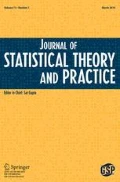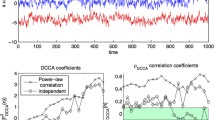Abstract
In this paper, we present a method of estimating the partial power spectrum of a bivariate point process. The method is based on the simple and cross-periodograms which are smoothed by applying a simple averaging weighting scheme in order to improve the properties of the estimate. The asymptotic distribution of the estimate is shown to be approximately normal when the amount of smoothing is large. An illustrative example is presented from the field of Neurophysiology when the complex system of the muscle spindle is affected by a static gamma motoneuron.



Similar content being viewed by others
References
Brillinger DR (1975) The identification of point process systems. Ann Probab 3(6):909–924
Brillinger DR, Bryant HL, Segundo JP (1976) Identification of synaptic interactions. Biol Cybern 22(4):213–228
Cox DR, Isham V (1980) Point processes. CRC Press, London
Rigas AG (1992) Spectral analysis of stationary point processes using the fast fourier transform algorithm. J Time Ser Anal 13(5):441–450
Rigas AG (1996) Spectral analysis of a stationary bivariate point process with applications to neurophysiological problems. J Time Ser Anal 17(2):171–187
Haduch-Sendecka A, Pietruszka M, Zajdel P (2014) Power spectrum, growth velocities and cross-correlations of longitudinal and transverse oscillations of individual nicotiana tabacum pollen tube. Planta 240(2):263–276
Wang R, Wang J, Yu H, Wei X, Yang C, Deng B (2015) Power spectral density and coherence analysis of alzheimer’s eeg. Cognit Neurodyn 9(3):291–304
Sherman MA, Barton AR, Lodato MA, Vitzthum C, Coulter ME, Walsh CA, Park PJ (2018) Pasd-qc: quality control for single cell whole-genome sequencing data using power spectral density estimation. Nucleic Acids Res 46(4):e20. https://doi.org/10.1093/nar/gkx1195
Daley D, Vere-Jones D (1988) An introduction to the theory of point processes. Springer, Berlin
Bartlett MS (1963) The spectral analysis of point processes. J Royal Statistic Soc Ser B (Methodol) 25(2):264–281
Brillinger DR (1975) Estimation of product densities. In: Proceedings of the computer science and statistics 8th annual symposium at the Interface, pp 431–438
Brillinger DR (2001) Time series: data analysis and theory. SIAM, New York
Bloomfield P (2000) Fourier analysis of time series: an introduction, 2nd edn. Wiley, New York
Brillinger DR (1978) Comparative aspects of the study of ordinary time series and of point processes. In: Developments in statistics, vol 1, Elsevier, pp 33–133
Diggle PJ (1990) Time series: a biostatistical introduction. Clarendon Press, Oxford
Priestley MB (1981) Spectral analysis and time series: probability and mathematical statistics. Academic Press, London
Boyd IA (1962) The structure and innervation of the nuclear bag muscle fibre system and the nuclear chain muscle fibre system in mammalian muscle spindles. Philos Trans Royal Soc Lond Ser B Biol Sci 245(720):81–136
Boyd IA (1980) The isolated mammalian muscle spindle. Trends Neurosci 3(11):258–265
Matthews PB (1981) Evolving views on the internal operation and functional role of the muscle spindle. J Physiol 320(1):1–30
Johansson H (1981) Reflex control of \(\gamma\)-motoneurones. Umea Univ Med Dissert 68:55–57
Proske U, Wise AK, Gregory JE (2000) The role of muscle receptors in the detection of movements. Prog Neurobiol 60(1):85–96
Proske U, Gandevia SC (2012) The proprioceptive senses: their roles in signaling body shape, body position and movement, and muscle force. Physiol Rev 92(4):1651–1697
Gentleman WM, Sande G (1966) Fast fourier transforms: for fun and profit. In: Proceedings of the Fall joint computer conference, November 7–10, 1966, pp 563–578
Tsitsis DS, Karavasilis GJ, Rigas AG (2012) Measuring the association of stationary point processes using spectral analysis techniques. Statistic Methods Appl 21(1):23–47
Vassiliadis VG, Spyroglou II, Rigas AG, Rosenberg J, Lindsay K (2019) Dealing with the phenomenon of quasi-complete separation and a goodness of fit test in logistic regression models in the case of long data sets. Statistics Biosci 11(3):567–596
Spyroglou II, Rigas AG (2018) A two-step bayesian approach for modeling a complex neurophysiological system. Int J Biol Biomed Eng 12:66–74
Brockwell PJ, Davis RA (1991) Time series: theory and methods. Springer, New York
Acknowledgements
The authors are most grateful to Professor Ken Linsday and to Professor Jay Rosenberg for their kindness to provide the Neurophysiological data set.
Funding
This work was supported by European Regional Development Fund-Project “SINGING PLANT” \((No.\,CZ.02.1.01/0.0/0.0/16\_026/0008446)\) which received a financial contribution from the Ministry of Education, Youths and Sports of the Czech Republic in the form of special support through the National Program for Sustainability II funds.
Author information
Authors and Affiliations
Corresponding author
Ethics declarations
Conflicts of interest
The authors declare that they have no conflict of interest.
Additional information
Publisher's Note
Springer Nature remains neutral with regard to jurisdictional claims in published maps and institutional affiliations.
Part of special issue guest edited by Dieter Rasch, Jürgen Pilz, and Subir Ghosh—Advances in Statistical and Simulation Methods.
Appendix
Appendix
1.1 Proofs of Theorems
-
Proof of Theorem 1 Let \(g: \; R^3\rightarrow R\) be a differentiable function with \(g(x,y,z)=\frac{xy}{z},\; z \ne 0\). By setting \(x=f_{kl}(\lambda ), \; y=f_{lk}(\lambda )\) and \(z=f_{ll}(\lambda )\), and using the multivariate delta method, we get that [27]:
$$\begin{aligned} g(\hat{x},\hat{y},\hat{z})-g(x,y,z)=\frac{f_{kl}^{(T)}(\lambda ) f_{lk}^{(T)}(\lambda )}{f_{ll}^{(T)}(\lambda )}-\frac{f_{kl}(\lambda )f_{lk}(\lambda )}{f_{ll}(\lambda )}, \end{aligned}$$which can be expressed as follows:
$$\begin{aligned}&g(\hat{x},\hat{y},\hat{z})-g(x,y,z)=\frac{\partial g}{\partial x}(\hat{x}-x)+\frac{\partial g}{\partial y}(\hat{y}-y)+ \frac{\partial g}{\partial z}(\hat{z}-z)\\&\quad =\frac{f_{lk}(\lambda )}{f_{ll}(\lambda )} \lbrace f_{kl}^{(T)}(\lambda )-f_{kl}(\lambda ) \rbrace +\frac{f_{kl}(\lambda )}{f_{ll}(\lambda )} \lbrace f_{lk}^{(T)}(\lambda )-f_{lk}(\lambda ) \rbrace \\&\qquad -\frac{f_{kl}(\lambda )f_{lk}(\lambda )}{f_{ll}^2(\lambda )} \lbrace f_{ll}^{(T)}(\lambda )-f_{ll}(\lambda ) \rbrace . \end{aligned}$$On using definitions (3) and (13), we find
$$\begin{aligned} f_{kk.l}^{(T)}(\lambda )-f_{kk.l}(\lambda )= & {} \lbrace f_{kk}^{(T)}(\lambda )-f_{kk}(\lambda ) \rbrace - \frac{f_{lk}(\lambda )}{f_{ll}(\lambda )} \lbrace f_{kl}^{(T)}(\lambda )-f_{kl}(\lambda ) \rbrace \nonumber \\&-\frac{f_{kl}(\lambda )}{f_{ll}(\lambda )}\lbrace f_{lk}^{(T)}(\lambda )-f_{lk}(\lambda ) \rbrace + \frac{f_{kl}(\lambda )f_{lk}(\lambda )}{f_{ll}^2(\lambda )} \lbrace f_{ll}^{(T)}(\lambda )-f_{ll}(\lambda ) \rbrace . \end{aligned}$$(17)It now follows from (17) that:
$$\begin{aligned} E \lbrace f_{kk.l}^{(T)}(\lambda ) \rbrace \simeq f_{kk.l}(\lambda ), \end{aligned}$$since \(E \lbrace f_{kk}^{(T)}(\lambda ) \rbrace \simeq f_{kk}(\lambda )\) and \(E \lbrace f_{kl}^{(T)}(\lambda ) \rbrace \simeq f_{kl}(\lambda ), \; (k \ne l)\). The covariance between \(f_{kk.l}^{(T)}(\lambda )\) and \(f_{kk.l}^{(T)}(\mu )\) is obtained as follows:
$$\begin{aligned} \mathrm {Cov} \lbrace f_{kk.l}^{(T)}(\lambda )-f_{kk.l}(\lambda ),f_{kk.l}^{(T)}(\mu )-f_{kk.l}(\mu ) \rbrace =\mathrm {Cov} \lbrace f_{kk.l}^{(T)}(\lambda ),f_{kk.l}^{(T)}(\mu ) \rbrace \end{aligned}$$and
$$\begin{aligned}&\mathrm {Cov} \lbrace f_{kk.l}^{(T)}(\lambda ),f_{kk.l}^{(T)}(\mu ) \rbrace =\mathrm {Cov} \lbrace f_{kk}^{(T)}(\lambda ),f_{kk}^{(T)}(\mu ) \rbrace - \frac{f_{lk}(-\mu )}{f_{ll}(\mu )} \mathrm {Cov} \lbrace f_{kk}^{(T)}(\lambda ),f_{kl}^{(T)}(\mu ) \rbrace \\&\quad -\frac{f_{kl}(-\mu )}{f_{ll}(\mu )} \mathrm {Cov} \lbrace f_{kk}^{(T)}(\lambda ),f_{lk}^{(T)}(\mu ) \rbrace + \frac{\mid f_{lk}(\mu ) \mid ^2}{f_{ll}^2 (\mu )}\mathrm {Cov} \lbrace f_{kk}^{(T)}(\lambda ),f_{ll}^{(T)}(\mu ) \rbrace \\&\quad - \frac{f_{lk}(\lambda )}{f_{ll}(\lambda )} \mathrm {Cov} \lbrace f_{kl}^{(T)}(\lambda ),f_{kk}^{(T)}(\mu ) \rbrace + \frac{f_{lk}(\lambda )}{f_{ll}(\lambda )} \frac{f_{lk}(-\mu )}{f_{ll}(\mu )}\mathrm {Cov} \lbrace f_{kl}^{(T)}(\lambda ),f_{kl}^{(T)}(\mu ) \rbrace \\&\quad +\frac{f_{lk}(\lambda )}{f_{ll}(\lambda )} \frac{f_{kl}(-\mu )}{f_{ll}(\mu )}\mathrm {Cov} \lbrace f_{kl}^{(T)}(\lambda ),f_{lk}^{(T)}(\mu ) \rbrace - \frac{f_{lk}(\lambda )}{f_{ll}(\lambda )} \frac{\mid f_{kl}(\mu ) \mid ^2}{f_{ll}^2 (\mu )} \mathrm {Cov} \lbrace f_{kl}^{(T)}(\lambda ),f_{ll}^{(T)}(\mu ) \rbrace \\&\quad - \frac{f_{kl}(\lambda )}{f_{ll}(\lambda )} \mathrm {Cov} \lbrace f_{lk}^{(T)}(\lambda ),f_{kk}^{(T)}(\mu ) \rbrace + \frac{f_{kl}(\lambda )}{f_{ll}(\lambda )} \frac{f_{lk}(-\mu )}{f_{ll}(\mu )} \mathrm {Cov} \lbrace f_{lk}^{(T)}(\lambda ),f_{kl}^{(T)}(\mu ) \rbrace \\&\quad + \frac{f_{kl}(\lambda )}{f_{ll}(\lambda )} \frac{f_{kl}(-\mu )}{f_{ll}(\mu )} \mathrm {Cov} \lbrace f_{lk}^{(T)}(\lambda ),f_{lk}^{(T)}(\mu ) \rbrace -\frac{f_{kl}(\lambda )}{f_{ll}(\lambda )} \frac{\mid f_{kl}(\mu ) \mid ^2}{f_{ll}^2 (\mu )} \mathrm {Cov} \lbrace f_{lk}^{(T)}(\lambda ),f_{ll}^{(T)}(\mu ) \rbrace \\&\quad + \frac{\mid f_{kl}(\lambda ) \mid ^2}{f_{ll}^2(\lambda )} \mathrm {Cov} \lbrace f_{ll}^{(T)}(\lambda ),f_{kk}^{(T)}(\mu ) \rbrace - \frac{\mid f_{kl}(\lambda ) \mid ^2}{f_{ll}^2(\lambda )} \frac{f_{lk}(-\mu )}{f_{ll}(\mu )} \mathrm {Cov} \lbrace f_{ll}^{(T)}(\lambda ),f_{kl}^{(T)}(\mu ) \rbrace \\&\quad -\frac{\mid f_{kl}(\lambda ) \mid ^2}{f_{ll}^2(\lambda )} \frac{f_{kl}(-\mu )}{f_{ll}(\mu )} \mathrm {Cov} \lbrace f_{ll}^{(T)}(\lambda ),f_{lk}^{(T)}(\mu ) \rbrace \\&\quad + \frac{\mid f_{kl}(\lambda ) \mid ^2}{f_{ll}^2(\lambda )} \frac{\mid f_{kl}(\mu ) \mid ^2}{f_{ll}^2(\mu )} \mathrm {Cov} \lbrace f_{ll}^{(T)}(\lambda ),f_{ll}^{(T)}(\mu ) \rbrace , \end{aligned}$$since \(f_{lk}(\lambda )=f_{kl}(-\lambda )\), \(\mid f_{lk}(\lambda ) \mid ^2 = \mid f_{kl}(\lambda ) \mid ^2\) and
$$\begin{aligned} \mathrm {Cov} \lbrace f_{kl}^{(T)} (\lambda ), a(\lambda )f_{kl}^{(T)}(\mu ) \rbrace = \overline{a(\lambda )} \mathrm {Cov} \lbrace f_{kl}^{(T)} (\lambda ), f_{kl}^{(T)}(\mu ) \rbrace , \end{aligned}$$where \(\overline{a(\lambda )}\) is the conjugate function of the complex function \(a(\lambda )\). If we substitute in the above relation the covariances from (12), we obtain the required result. If we set \(\lambda =\mu\) in the \(\mathrm {Cov} \lbrace f_{kk.l}^{(T)} (\lambda ), f_{kk.l}^{(T)}(\mu ) \rbrace\), we get
$$\begin{aligned}&\mathrm {Var} \lbrace f_{kk.l}^{(T)}(\lambda ) \rbrace \simeq \frac{S}{T} \frac{C_p}{2m+1} \left[f_{kk}^2 (\lambda )-\frac{f_{kl}(\lambda )f_{kl}(-\lambda )f_{kk}(\lambda )}{f_{ll}(\lambda )}\right.\\&\left. \qquad -\frac{\mid f_{kl}(\lambda ) \mid ^2}{f_{ll}(\lambda )}f_{kk}(\lambda )+\frac{\mid f_{kl}(\lambda ) \mid ^2 f_{kl}(\lambda ) f_{kl}(-\lambda )}{f_{ll}^2(\lambda )}-\frac{\mid f_{kl}(\lambda ) \mid ^2 f_{kk}(\lambda )}{f_{ll}(\lambda )}\right.\\\\&\left.\qquad +\frac{\mid f_{kl}(\lambda ) \mid ^2 f_{kk}(\lambda )}{f_{ll}(\lambda )}+\frac{\mid f_{kl}(\lambda ) \mid ^2 \mid f_{kl}(\lambda ) \mid ^2}{f_{ll}^2(\lambda )}-\frac{\mid f_{kl}(\lambda ) \mid ^2 \mid f_{lk}(\lambda ) \mid ^2}{f_{ll}^2(\lambda )}\right.\\&\left.\qquad -\frac{\mid f_{lk}(\lambda ) \mid ^2 f_{kk}(\lambda )}{f_{ll}(\lambda )}+ \frac{\mid f_{kl}(\lambda ) \mid ^2 \mid f_{kl}(\lambda ) \mid ^2}{f_{ll}^2(\lambda )}+\frac{f_{kl}(\lambda )f_{kl}(-\lambda )f_{kk}(\lambda )}{f_{ll}(\lambda )}\right.\\&\left. \qquad - \frac{\mid f_{kl}(\lambda ) \mid ^2 f_{kl}(\lambda )f_{kl}(-\lambda )}{f_{ll}^2(\lambda )}+\frac{\mid f_{kl}(\lambda ) \mid ^2 f_{lk}(\lambda )f_{lk}(-\lambda )}{f_{ll}^2(\lambda )}-\frac{\mid f_{kl}(\lambda ) \mid ^2 \mid f_{kl}(\lambda ) \mid ^2}{f_{ll}^2(\lambda )}\right.\\&\qquad \left. -\frac{\mid f_{kl}(\lambda ) \mid ^2 f_{lk}(\lambda )f_{lk}(-\lambda )}{f_{ll}^2(\lambda )}+\frac{\mid f_{kl}(\lambda ) \mid ^2 \mid f_{kl}(\lambda ) \mid ^2}{f_{ll}^2(\lambda )} \right]\\&\quad =\frac{S}{T}\frac{C_p}{2m+1} \left [f_{kk}^2(\lambda )-\frac{2\mid f_{kl}(\lambda ) \mid ^2 f_{kk}(\lambda )}{f_{ll}(\lambda )}+\frac{\mid f_{kl}(\lambda ) \mid ^2 \mid f_{kl}(\lambda ) \mid ^2}{f_{ll}^2(\lambda )}\right]\\&\quad =\frac{S}{T}\frac{C_p}{2m+1} f_{kk}^2(\lambda )\left[1-2 \mid R_{kl}(\lambda ) \mid ^2 + \mid R_{kl}(\lambda ) \mid ^4 \right]\\&\quad =\frac{S}{T}\frac{C_p}{2m+1}\left [f_{kk}(\lambda )(1-\mid R_{kl}(\lambda ) \mid ^2)\right]^2=\frac{S}{T}\frac{C_p}{2m+1}f_{kk.l}^2(\lambda ). \end{aligned}$$ -
Proof of Proposition 1 The distribution of \(f_{kk}^{(T)}(\lambda _j)\) is a multiple of a \(\chi ^2\)-distribution with \(2(2m+1)\) degrees of freedom. Moreover, the variates \(\lbrace f_{kk}^{(T)}(\lambda _j) \rbrace ,\, j=1,2,\ldots ,J\) are asymptotically independent distributed. For large m, the variates \(\lbrace f_{kk}^{(T)}(\lambda _j) \rbrace ,\, j=1,2,\ldots ,J\) are asymptotically independent normally distributed. Also, the distribution of \(f_{kl}^{(T)}(\lambda _j)\) follows a Wishart distribution, \(\frac{1}{2m+1}W_1^C \lbrace 2m+1, f_{kl}(\lambda _j) \rbrace\). The variates \(\lbrace f_{kl}^{(T)}(\lambda _j) \rbrace ,\, j=1,2,\ldots ,J\) are asymptotically independent distributed. For large m the Wishart distribution tends to a normal distribution. For more details refer to [12].
For large m, the estimate of PPS approximated by (17) is the sum of 4 independent normal distributions, therefore tends to a normal distribution with mean and variance obtained in Theorem 1.
-
Proof of Proposition 2: This follows in the same way as the logarithm to base 10 of the estimate of the PS [12].
Rights and permissions
About this article
Cite this article
Michailidis, G.E., Spyroglou, I.I., Zaridis, D. et al. A Method of Estimating the Partial Power Spectrum of a Bivariate Point Process and an Application to a Neurophysiological Data Set. J Stat Theory Pract 14, 36 (2020). https://doi.org/10.1007/s42519-020-00105-8
Published:
DOI: https://doi.org/10.1007/s42519-020-00105-8




